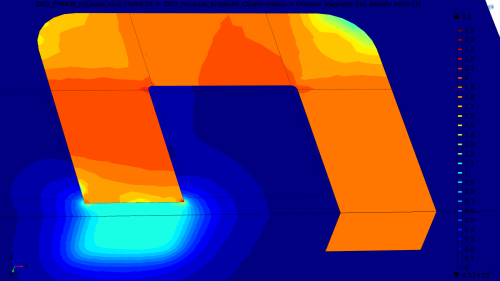Magnetic field in air-gap of ferromagnetic yokes – investigations and calculations
The magnetic field in the air-gap of highly energized ferromagnetic yokes was investigated.
It is known that the flux densities in a yoke Byoke and in an air-gap Bgap are similar in size only if the air-gaps length is very small compared with the transverse dimensions of the yoke resp. the pole. If this geometric condition is not carry out the magnetic field in the gap will spread perpendicular to the field direction and the flux density Bgap will be smaller than Byoke.
The measurements and parallel 3D FEM calculations were carried out on yokes with
- diameters Ø = 60mm and 76mm (pole with circular cross-section)
- diagonals D ≈ 110mm (poles with rectangular cross-section)
- air gaps s = 10 .. 50mm
The field measurements in the air gap and the yoke yielded the expected results:
The field widening depends on the size
- of the gap length
- of the ratio of gap length to transverse dimensions of the yoke
- of the magnetomotive force Θ = n * i
The following diagram is an example of the dependence Bgap on Θ = n * i (air gap s = 10mm, part of measurements only, measured in the center of the air gap at half the gap length).

Quantitative measurements of the size and homogeneity of field Bgap in the air gap are very time consuming. For this reason numerous variations were calculated with a FEM program. There were also varied the geometry and material of the yoke and the pole shoes, the air gap and the magnetomotive force. In particular the effect of pole shoes was almost exclusively calculated and optimized by means of FEM models.
It has been found, that in cases in which measurement results could be directly compared with the FEM-calculations, there was invariably very good correspondence.
Excamples of FEM-calculations are given in the following two figures. The results depend strongly on the magnetomotive force.


It can be seen that the geometrical symmetry of the yokes and air gaps are used for models. It can be seen further
- the change in flux density at the interface pole / air gap
- the field widening (referred to a significant flux density Bgap)
- a remarkable homogeneity of Bgap in the area of the cross-section Apole of poles.